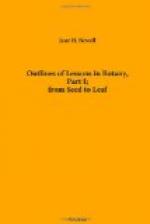3. Comparison with other Dicotyledons.—The pupils should now have other seeds to compare with these four. Let them arrange Flax, Four o-clock, Horsechestnut, Almond, Nasturtium, Maple-seeds, etc., under two heads.
Seeds with the Food stored Seeds with the Food stored outside the plantlet in the embryo itself (Albuminous)_. (Exalbuminous)_.
Flax. Four-o’clock.
Acorn. Horsechestnut. Almond.
Morning-Glory. Maple.
Sunflower. Squash.
Bean.
Pea. Nasturtium.
They may also be divided into those with and without the plumule.
Without Plumule. With Plumule.
Flax. Maple. Sunflower.
Acorn. Horsechestnut.
Four-o’clock.
Almond. Bean. Pea.
Morning-Glory. Squash.
Nasturtium.
Those with plumules will be seen to have the most abundant nourishment. In many cases this is made use of by man.
These last can be again divided into those in which the cotyledons come up into the air and those where they remain in the ground.
In the Air. In the Ground.
Bean. Almond. Squash.
Acorn. Horsechestnut.
Pea.
Nasturtium.
In the latter the cotyledons are so heavily gorged with nourishment that they never become of any use as leaves. As Darwin points out, they have a better chance of escaping destruction by animals by remaining in the ground.
The cotyledons are very good illustrations of the different uses to which a single organ may be put, and the thorough understanding of it will prepare the pupils’ minds for other metamorphoses, and for the theory that all the various parts of a plant are modified forms of a very few members.
4. Nature of the Caulicle.—Probably some of the pupils will have called the caulicle the root. It is, however, of the nature of stem. The root grows only at the end, from a point just behind the tip; the stem elongates throughout its whole length. This can be shown by marking the stem and roots of a young seedling with ink. India ink must be used, as common ink injures the plants. Dip a needle in the ink and prick a row of spots at equal distances on a young root. Corn is very good for this purpose, but Morning-Glory or Bean is better for experiments on the stem. The plants should then be carefully watched and the changes in the relative distance of the spots noted. The experiment is very easily conducted with the seedlings growing on sponge, with their roots in the moist air of the tumbler, as before described.




